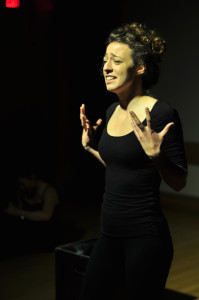
“These are all people with stories. They all have a history – a present and a future,” proclaims Noah Arthurs ’18 in the final monologue of the Stanford Asian American Theater Project’s performance of “Stanford Monologues: Behind the Bubble.” This production, which played last week at the Elliot Programming Center (EPC), features nine actors reading compelling stories by real Stanford students — about issues such as race, gender, sexuality, religion and disability — compiled by playwright Joseph Lee ’17 into a piece of theater that tries to make us understand the diverse perspectives of Stanford students.
The stage is bare but for a few benches and blocks in the intimate EPC theater space. The actors deliver their monologues with little to no movement in front of the other actors who are in tableau, not speaking to each other. This lack of dialogue between the majority of actors onstage mirrors the themes of loneliness and isolation that permeate this production. While I had the sense the actors may have wanted to physicalize their deliveries more, the relatively stationary performances focused the production on the true strength of the show: the honest and authentic stories Stanford students shared for the piece.

Sackes courtesy of AATP.
While the actors had not experienced the anonymous stories they were sharing, most of them seemed to personally connect with them in some way. Lea-Tereza Tenekedjieva ’18 especially stood out for her delivery of an emotionally truthful account of having to give up dance because of a disability. And Matt Leong ’17 delivered a commendably humorous account of “turning Asian” when he moved to the United States.
But the show struggled when taking on an overly didactic or at times preachy quality. This was particularly noticeable in the final monologue, in which Arthurs expounds, “Stories help us understand that we are not alone, that there is no other. Stories are the bridge. People don’t know who we are because they haven’t heard our stories.” While this may be true, the production didn’t have to justify itself or synthesize the stories into one message; the stories are powerful enough on their own, and trying to fuse them into a message rather than letting each story stand on its own had the effect of simplifying issues of diversity in a show that ideally should be showing the complexity of such issues.
“Stanford Monologues: Beyond the Bubble” was a commendable effort to try to use theater as a “force for social change,” as co-director Adi Chang ’18 describes in his director’s notes, featuring moving stories delivered by actors who seemed connected to the source material. I admire this valiant attempt to create theater that is trying to fight against the pitfalls of the Stanford Duck Syndrome and speak out against something that often goes unexplored on the Stanford campus. We need more theater like this. We also need more theater that is not neatly packaged and self-congratulatory, theater that doesn’t make us feel like we can solve a major problem simply by telling stories. We need theater that presents issues with the complexity they truly involve.
Contact Steve Rathje at srathje ‘at’ stanford.edu.
